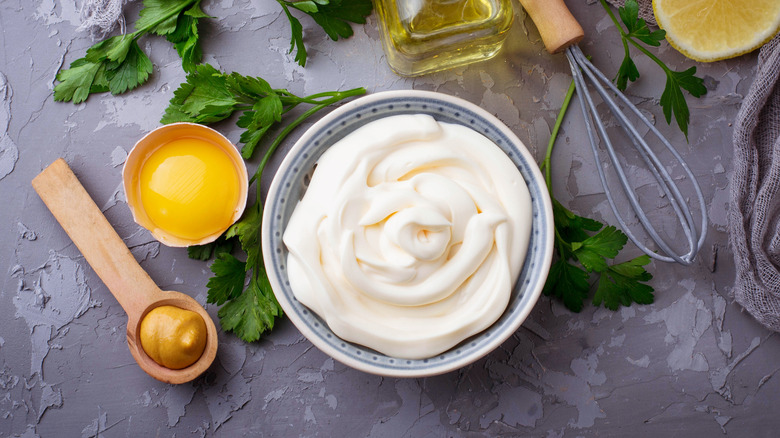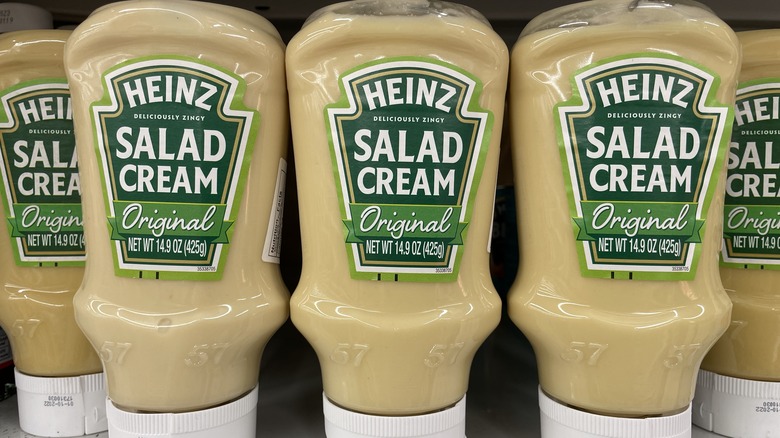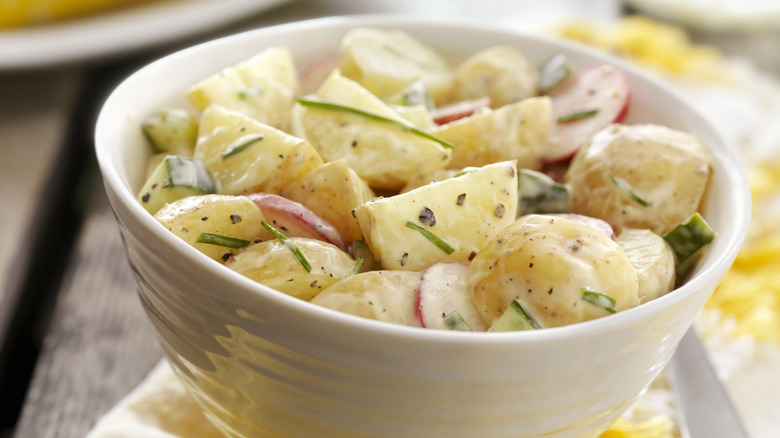Is Salad Cream The Same As Mayo?
We may receive a commission on purchases made from links.
Both salad cream and mayonnaise are whitish-yellow condiments used in similar ways, though they differ in flavor and texture. Salad cream looks more golden in color and has a thinner consistency versus thicker, whiter mayo. Both can be used for sandwiches, deviled eggs, dipping sauces, or in classic creamy salads that feature potato, egg, or pasta bases.
The ingredients are also quite similar. Homemade salad cream is made up of eggs, mustard, cream, salt, sugar, and an acid like vinegar or lemon juice, but no oil. The popular Heinz salad cream ingredients list is similar, but substitutes oil and corn flour for the cream. The flavor is zingy and bright. Mayonnaise combines egg yolks, oil, acid, and salt, with many homemade versions incorporating mustard. Store-bought products tend to nix mustard, and some also add sugar. Either way, mayo leans mild and creamy.
The key differences between the two condiments lays in the treatment of the eggs and preparation technique. Salad cream always incorporates cooked eggs. The original method to make it involves a double boiler wherein a bowl is gently heated via steam from a pot of simmering water below. Lightly cooking the eggs and vinegar in this setup creates an emulsion. Some more modern versions use blended hard-boiled eggs as the base instead. On the other hand, mayonnaise starts with an emulsion of raw egg yolks and oil. As the eggs are whisked, the oil is slowly streamed in, which transforms the two distinct ingredients into a creamy, voluminous spread.
The histories of mayo and salad cream
Though there is no certain origin story, mayonnaise was created around the mid-1700s either in France or Spain. One story says the invention came from a French chef who made mayo as a substitute for a cream sauce to celebrate the capture of the Spanish territory of Port Mahon, while Spaniards attest that it has long been a local dish in Minorca. Either way, the French ran with the idea, and it spread to the United States via French chefs and cookbooks. Creamy lobster and chicken salads from New York City institution Delmonico's put mayo on the map in the 1830s.
Around the same time, Northern Europeans wanted to jump on the mayonnaise train. However, commercially produced vegetable oil was only just becoming widely available, and olive oil was not readily accessible either. Salad cream — known as a boiled dressing because of the cooking technique — provided a suitable, oil-free stand-in.
In 1914, Heinz released the first packaged salad cream, which cemented the product as a British favorite. This industrialized condiment proved cheaper than homemade mayo, which allowed salad cream to remain accessible despite increased food prices due to World War I. Across the pond, mayonnaise was first packaged and sold in 1920 by a name mayo lovers will recognize — Richard Hellmann. As Americans covered sliced bread sandwiches and Waldorf salads in mayonnaise, Brits — and those in British colonies — used salad cream widely on everything from chips and beans to Belizean stewed beans and rice.
When to use salad cream versus mayo
Salad cream remains a popular British condiment. Those outside of Britain, its territories, or former colonies do struggle to find salad cream in stores, but fortunately, it is available online from retailers like Amazon. If you happen to have both on hand, you can often use them interchangeably, depending on the flavor you are after.
When you want a brighter flavor profile and lighter texture, go for salad cream. The taste is more mustard- and vinegar-forward than regular mayonnaise. It lends balance in dishes like coleslaw on the side of a pile of sweet barbecue ribs or a BLT loaded with smoky, thick-cut bacon. Because it has a tangier taste and thinner texture, it can also stand alone spooned right over a green salad or char-grilled veggies.
Keep in mind that salad cream is not thick enough to support many dips and spreads. Consider simple pimento cheese, which is made of shredded cheddar, pimentos, cream cheese, and mayonnaise. Salad cream just doesn't have the weight to bring all those ingredients together. Chicken or tuna salad destined for sandwiches is another example that is better off with mayo, though if served over a bed of greens, you could get away with salad cream. If you want the tang, but require the texture of mayo, consider using half-and-half, or upgrade store-bought mayo with an extra hit of vinegar, lemon juice, or mustard to mimic salad cream.



